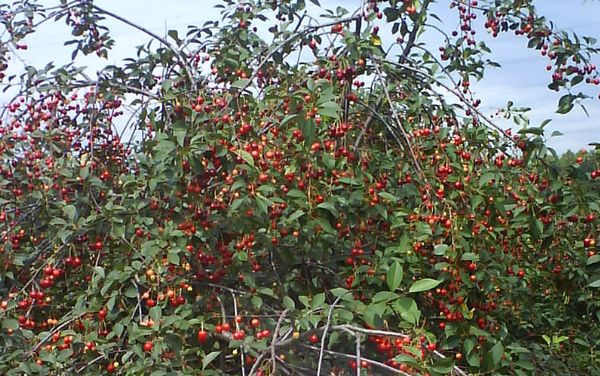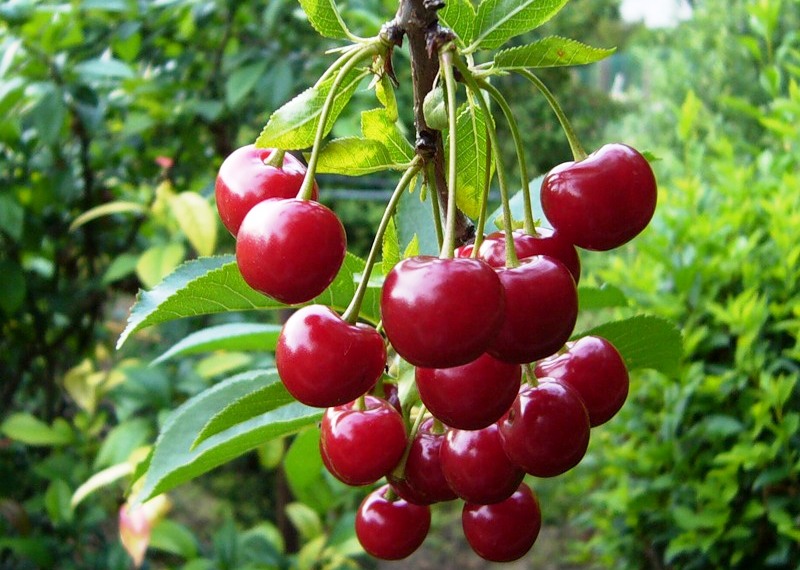High-yielding youth cherry
Cherry is one of the most popular fruit trees in our garden. It can be found in almost any garden. Breeders have bred a large number of varieties of the most diverse in their characteristics. One of them, namely Molodezhnaya cherry, will be discussed in this article. Here we will consider the description of this variety, its characteristics, advantages and disadvantages.
Content
Description of the variety
The Molodezhnaya Cherry variety was bred by breeders as a result of crossing Vladimirskaya and Lyubskaya cherries. Refers to the type of ordinary cherry (as, for example, the varieties Rusinka, Morozovka, Mayak, etc.) According to its characteristics and properties, it is similar to the variety Malinovka. Today it is widespread. It can be found in Ukraine, Belarus, Russia.
This type of cherry can be represented by both a tree and a bush. The appearance of the tree is shown in the photo below.

The maximum height that a tree or bush can grow is 2.5 meters. The crown of this variety is slightly drooping and rounded. The leaves of the Youth Cherry are medium in size and bright green in color. Crenate edges are characteristic of the pattern of the leaf blade.
This cherry tree begins to bear fruit on growths from the previous year, as well as bouquet branches.
The youth variety is characterized by early maturity. Begins to bear fruit from the age of four. The berries ripen in mid-July. Its fruits can reach a mass of 4.5 g. They are oval in shape, up to a centimeter in diameter (photo below). The Molodezhny variety bears sweet and sour fruits. The fruit has a dense pulp that is very juicy. Cherry juice is dark red in color. The stone is medium in size and quite easily separated from the pulp. The youth variety, according to the tasting characteristics of its fruits, belongs to the dessert. Its fruits are used both for fresh food and for all types of preservation. Berries are used to make compotes, preserves, jams and marmalades.

From one bush or tree during the fruiting period, you can collect up to 12 kg of the crop.
This type of youth cherry belongs to the group with an average winter hardiness. The resistance of the flower buds is also average. According to the description, it is similar to the Vladimirsky variety. This cherry is moderately resistant to various diseases (coccomycosis and moniliosis) and microorganisms. The tree is especially sick during the wet and warm summer.
Advantages and disadvantages
The advantage of this type of cherry is that it is one of the most reliable varieties in terms of yield, which are presented in nurseries of all large cities (Moscow, Kiev, Minsk, etc.).
The advantages also include:
- self-fertility of the variety;
- early maturity;
- resistance to the most dangerous fungal diseases;
- high productivity;
- the presence of large and juicy fruits;
- easy separation of the bone from the pulp;
- excellent taste characteristics of berries;
- good transportability;
- resistance of flowers and wood to the influence of dry eastern air, as well as cold winters, severe frosts.
Such cherries can be used as a pollinator for other, later varieties.
Sufficiently striking and significant shortcomings for this type of fruit tree have not been identified. The main disadvantages of such a cherry are as follows:
- the need for annual treatment with fungicidal preparations that will reduce the risk of developing fungal infections;
- resistance to various infections decreases in humid and warm climates;
- the need for the correct selection of the planting site, on which the growth of the seedling directly depends.Poorly ventilated and flat areas are not suitable for it;
- an annual feeding of the tree with phosphorus, nitrogen, potassium is necessary. With a lack of these elements in the soil, the yield is significantly reduced;
- tendency to strong overgrowth.
However, the advantages of this cherry outweigh its disadvantages.
How to grow
In order for your tree to bear fruit perfectly, and the quality of the crop to be excellent, it is necessary to plant, grow and care for it correctly.
The best time to plant youth cherries is spring. This tree should be planted on hills and in well-lit areas of the garden, where groundwater passes close, and the soil is slightly alkaline or neutral. Planting is carried out in a pit with parameters 40x80 cm (depth, diameter), into which organic fertilizers are added before planting.
After planting, every spring, fertilizing with nitrogen fertilizers is carried out, the amount of which depends on the age of the tree. And in the fall, fertilizing is carried out with potash and phosphorus fertilizers. For better growth, manure or compost is also added to the soil.
Cherries are very fond of water, so it is recommended to water it more often. Every year you need to carry out preventive treatment in order to prevent infection. Since its crown is prone to thickening, during the growth of cherries, pruning is carried out (in spring or autumn).
Cherry Growing Video
In this video you can find a detailed description of the correct cultivation of youth cherries.
Youth cherry will be an appropriate and high-quality addition to your garden, since its appearance is not very typical for a tree, and the fruits have very positive properties. No matter how much it bears fruit, you will not be able to get bored with its fruits.
